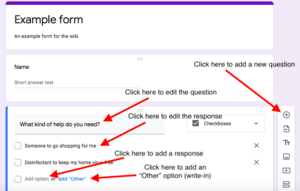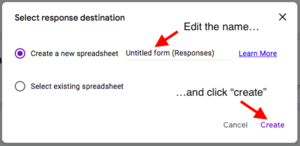Ingesting cases via a Google form protocol
This protocol is a draft. It has not yet been accepted as protocol and may be incorrect or poorly cited. Please do not use this in your work until it has been accepted.
Please see #protocols on Slack to discuss this protocol further.
When running a mutual aid group during the COVID-19 pandemic, it is useful to have a convenient way for people in need to provide you with the information you need to support them. This protocol describes how to create a Google form to collect this information.
Once you have this information, you can follow putting records on a map protocol to put the records on a map, and dispatch within a local group protocol to actually handle the requests.
How to ingest via a Google form
- Navigate to https://www.docs.google.com/forms
- If you have a Google account, you may need to log in. Make sure you are logged in from the correct account, as this account will be the one that receives the information! If you do not have a Google account, you will need to create one.
- At the top of the page under "Start a new form", click "Blank".
- Give your form a title and (possibly) a description. (Click the default title and description to edit them.)
- Create questions for all the information you will need. The first question is automatically created, but to add more questions you will need to click the (+) button on the right. (See next section for the kind of information you will need to collect.)
- Click on each question to edit it, filling in the question itself and selecting the type of response from the drop-down. If the type of question has options for the response, you will need to add the right number of responses (by clicking the text that reads "add option") and edit what they say.
- When you are done writing the questions, click the tab labelled "responses" at the top.
- Click the green icon with a white cross in it, found to the right of the screen.
- Select the "Create a new spreadsheet" option, and give the spreadsheet a name.
- Click "Create" at the bottom of the box. Now your form is live, and responses will be put into the spreadsheet. Be very careful who has access to this spreadsheet, as the contents constitute personally-identifiable information about your requestees.
- Click the green icon again to open the spreadsheet and add an extra column to record whether the request has been handled yet.
- Go back to the "Questions" tab on the form and copy the URL from your browser's address bar. This is the URL of your form; spread it around!
What information to collect
At a minimum, you should be collecting:
- Name (as a "short answer")
- The kind of help needed (as checkboxes with an "other" option)
- Whether the request is urgent or not (as multiple choice, possibly with an "other" option)
- Location, such as a postcode (as a "short answer")
- Contact details (as a "short answer"; consider specifying your preferred form of contact like phone or e-mail)
You might also consider collecting information like:
- Pronouns
- How the requestee can pay for food
- Whether the requestee experiences certain forms of oppression (if your group intends to prioritise such cases)
In general you should aim to collect the minimum amount of information needed to do the work. This makes it easier for the requestee as well as reducing the amount of personally-identifiable information you'll be having to deal with.

